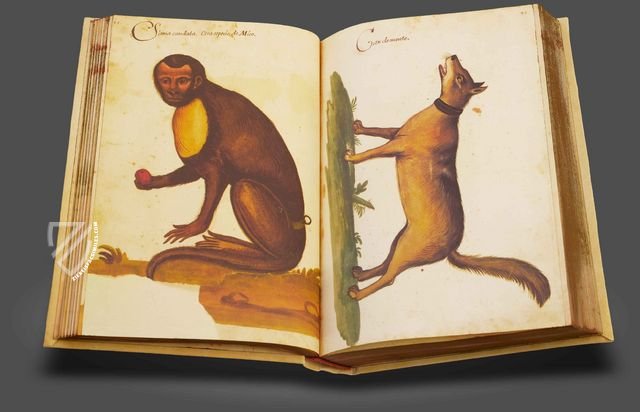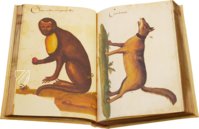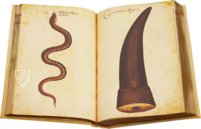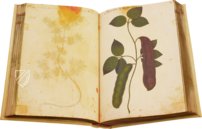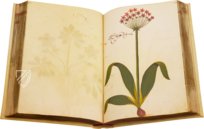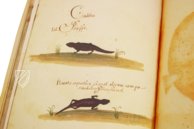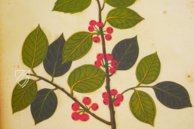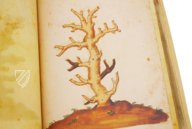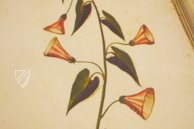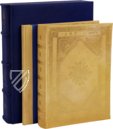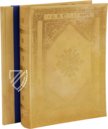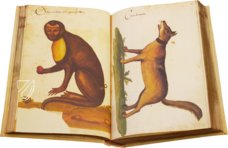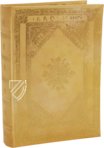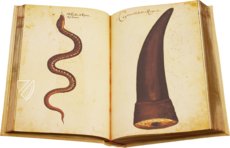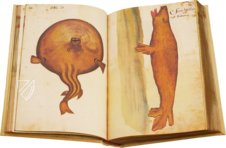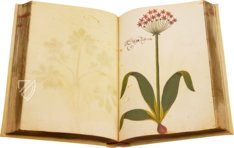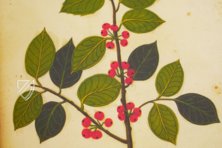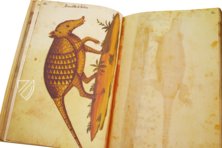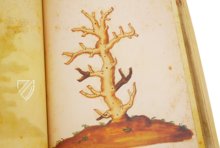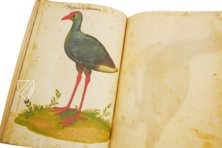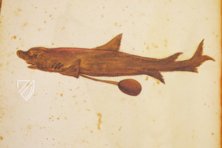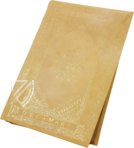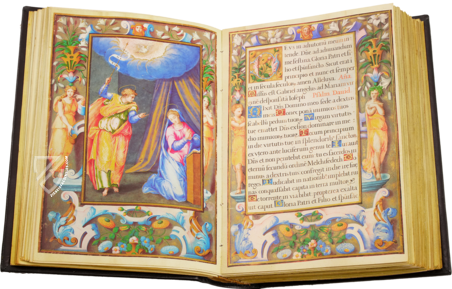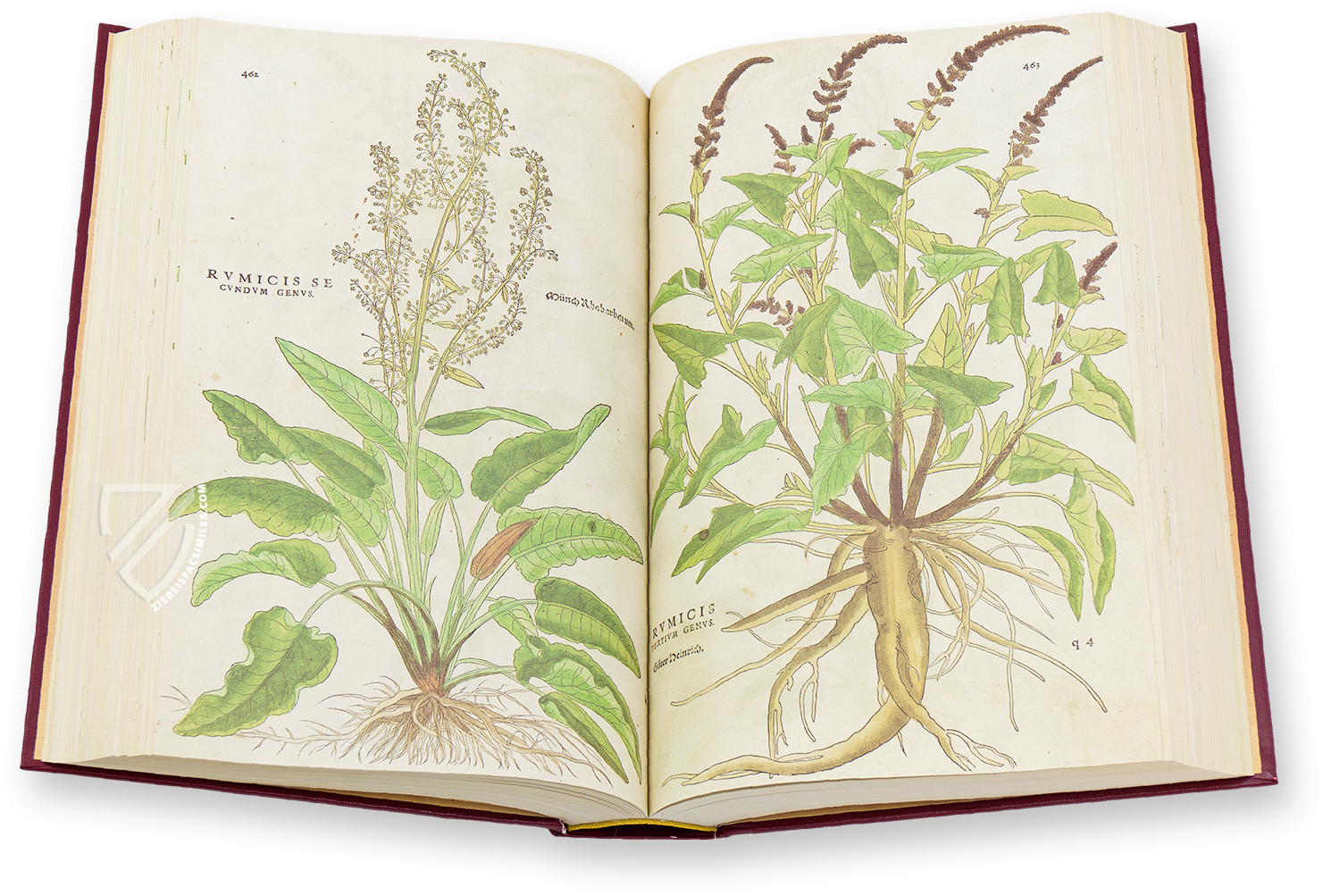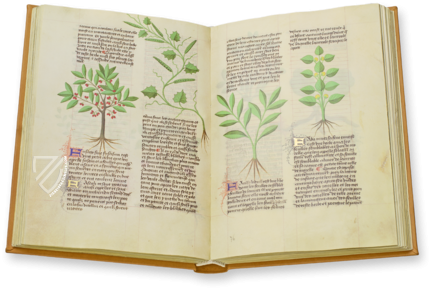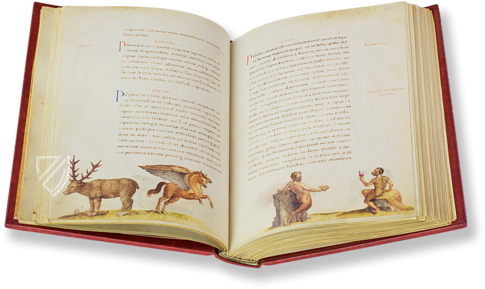Natural History Atlas of Philip II - Pomar Codex
(1,000€ - 3,000€)
The 16th century Natural History Atlas of Philip II of Spain is one of the first significant illuminated manuscripts about biology in the Middle Ages. It contains charmingly colored miniatures in great fidelity conveying an inside view of the unbelievably great medical and biological knowledge of people during the Renaissance. Philip II dedicated the precious text to his personal physician and confidant Dr. Honoratio Pomar, one of the University of Valencia’s most famous scientists.
Natural History Atlas of Philip II - Pomar Codex
The Atlas Historiae Naturalis is one of the first colored illuminated manuscripts of the Middle Ages that was concerned with the lifeworld of animals and plants. The significant scientific work contains over 218 richly detailed illustrations of the most diverse creatures and plants. The manuscript documents the high level of knowledge about biology in the Middle Ages, which had to be acquired by researchers at the time completely without technical aids. King Philip II of Spain personally commissioned the informative text and dedicated it to one of his close confidants, namely Dr. Honorato Pomar. It is for this reason that the natural history atlas is also known by as the Pomar Codex.
An Age of Science
The Atlas Historiae Naturalis originated during the 16th century, during the Renaissance era. There is hardly another epoch during which more scientific breakthroughs occurred than the Renaissance. Not only were technology, mathematics, and physics on the rise during the time when Nicolaus Copernicus and Isaac Newton lived, but the disciplines of medicine and biology also reached new levels during the Renaissance. The Natural History Atlas of Philip II united all of the biological knowledge of that time in a comprehensive and informative codex. Its excellent, natural and realistic miniatures provides laymen and natural-historically interested readers with a thorough insight into their biological surroundings and provides explanations about the modus vivendi of various kinds of animals and plants. The astounding work continued to possess an immeasurable scientific worth centuries after its genesis.
At the Behest of the King
Philip II of Spain inherited the Kingdom of Spain, her American colonies, the Netherlands, the Free-County of Burgundy, the Kingdoms of Sicily and Naples, the Kingdom of Sardinia, and the Duchy of Milan as the oldest and only surviving son of Charles the V and Isabella of Portugal. The indescribably powerful monarch enjoyed an excellent and comprehensive academic education. His love of literature was already noticeable from a young age. His private library compiled over 13,500 outstanding manuscripts by the time of his death, many of which still exist today and some of which are worth a small fortune. The Atlas Historiae Naturalis possessed a particularly personal significance for Philip, its patron. The magnificent manuscript contains the following dedication on its first page of text: “Our King Philip II presented this book to his personal physician Dr. Honorato Pomar of Valencia, professor of medicinal plants at the University of Valencia.” Dr. Pomar belonged to the circle of the King’s closest confidants and attended to him on a nearly daily basis. Philip gifted him the precious manuscript as a symbol of his great esteem, which the biologist relied on in his daily work.
Unbelievably Delightful Illumination
The fantastically designed miniatures of the Atlas Historiae Naturalis lend the manuscript its high historical and scientific worth. A variety of splendid illustrations exhibits the typical characteristics of the painting of the Italian illuminator Jacobo Ligozzi (1547–1627). Ligozzi, who was from Verona, was one of the most significant and talented painters of animals and plants during the Middle Ages. Even when his delightful miniatures do not bear a signature, the pictures can be attributed to Ligozzi with great certainty because of their stylistic similarities. Some illustrations in the atlas show plants and creatures, which could be found exclusively in America. One can assume that it deals with depictions of the flora and fauna of America because the first expeditions under the Spanish flag were taking place there at the time of the manuscript’s creation. It is possible that the manuscript showed discoveries from the famous expedition of Francisco Hernandez, who explored the natural environment of Mexico from 1571 to 1577. The miniatures not only possess high artistic worth, but also carry an incredibly great significance from a historical perspective.
Codicology
- Alternative Titles
- Atlas de historia natural de Felipe II (Códice Pomar)
Atlas Historiae Naturalis
Atlas Historiae Naturalis von Philipp II. - Pomar-Codex - Type
- Manuscript on paper
- Size / Format
- 648 pages / 34.8 × 23.7 cm
- Origin
- Spain
- Date
- Late 16th century – early 17th century
- Epochs
- Style
- Language
- Illustrations
- 218 naturalistic illustrations of plants and animals in colour painted on one-sided paper
- Patron
- King Philip II of Spain (1527–1598)
- Artist / School
- Jacobo Ligozzi (1547–1627)
- Previous Owners
- Jaime Honorato Pomar (ca. 1550–1606)
Perellós, Marchione de Dos Aguas
Natural History Atlas of Philip II - Pomar Codex
Armadillo de Indias
With a name meaning “little armored one” in Spanish, the armadillo is an extremely unusual mammal that is covered with plates of dermal bone, and many defend themselves by curling up into a ball. Their natural range stretches across South America and as far north as Texas. This handsome depiction is fairly accurate aside from the exaggerated size of the head and does a wonderful job of duplicating the patterned “shell” of the armadillo in addition to detailing its scaled skin and pointed ears.
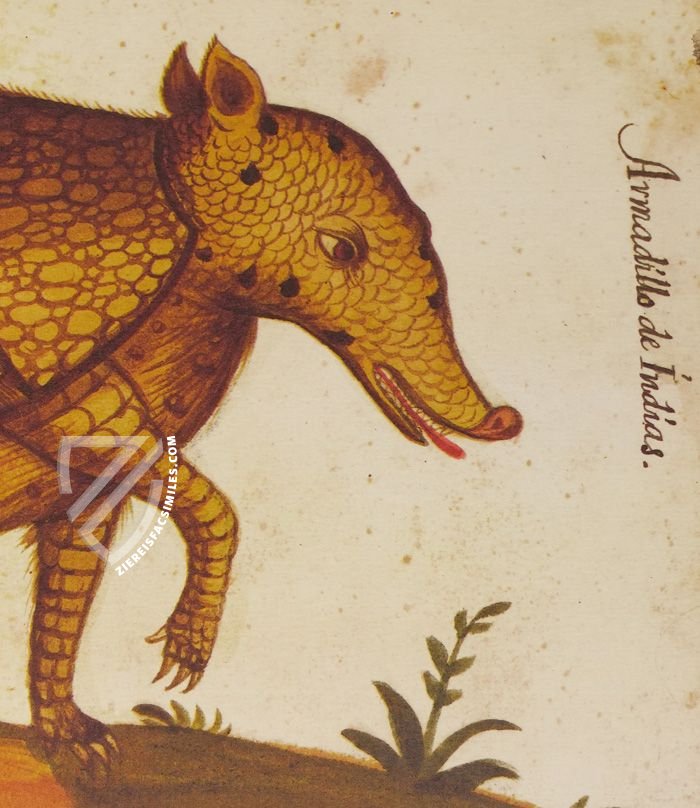
Natural History Atlas of Philip II - Pomar Codex
Holly
Labelled Aquifolium. Azebo. Hisp., this naturalist miniature of holly, instantly recognizable by its distinctive clumps of red berries, is impressive for its artistry, realism, and simplicity. Holly leaves have become a Christian symbol associated with the crown of thorns, and the berries represent drops of Christ’s blood spilled to redeem the world.
There are about 480 species worldwide, and rather than depicting common European holly, this variety appears to be from the Canary Islands, or could possibly be a hybrid. The branch is depicted sticking out from a larger bough, which has been cut or broken off, and the dark green leaves have light undersides. Most of the leaves are smooth, while others have the more iconic jagged edge.

#1 Atlas de historia natural de Felipe II (Códice Pomar)
Languages: English, Spanish
(1,000€ - 3,000€)
- Treatises / Secular Books
- Apocalypses / Beatus
- Astronomy / Astrology
- Bestiaries
- Bibles / Gospels
- Chronicles / History / Law
- Geography / Maps
- Saints' Lives
- Islam / Oriental
- Judaism / Hebrew
- Single Leaf Collections
- Leonardo da Vinci
- Literature / Poetry
- Liturgical Manuscripts
- Medicine / Botany / Alchemy
- Music
- Mythology / Prophecies
- Psalters
- Other Religious Books
- Games / Hunting
- Private Devotion Books
- Other Genres
- Afghanistan
- Armenia
- Austria
- Belgium
- Belize
- Bosnia and Herzegovina
- China
- Colombia
- Costa Rica
- Croatia
- Cyprus
- Czech Republic
- Denmark
- Egypt
- El Salvador
- Ethiopia
- France
- Germany
- Greece
- Guatemala
- Honduras
- Hungary
- India
- Iran
- Iraq
- Israel
- Italy
- Japan
- Jordan
- Kazakhstan
- Kyrgyzstan
- Lebanon
- Liechtenstein
- Luxembourg
- Mexico
- Morocco
- Netherlands
- Palestine
- Panama
- Peru
- Poland
- Portugal
- Romania
- Russia
- Serbia
- Spain
- Sri Lanka
- Sweden
- Switzerland
- Syria
- Tajikistan
- Turkey
- Turkmenistan
- Ukraine
- United Kingdom
- United States
- Uzbekistan
- Vatican City
- A. Oosthoek, van Holkema & Warendorf
- Aboca Museum
- Ajuntament de Valencia
- Akademie Verlag
- Akademische Druck- u. Verlagsanstalt (ADEVA)
- Aldo Ausilio Editore - Bottega d’Erasmo
- Alecto Historical Editions
- Alkuin Verlag
- Almqvist & Wiksell
- Amilcare Pizzi
- Andreas & Andreas Verlagsbuchhandlung
- Archa 90
- Archiv Verlag
- Archivi Edizioni
- Arnold Verlag
- ARS
- Ars Magna
- ArtCodex
- AyN Ediciones
- Azimuth Editions
- Badenia Verlag
- Bärenreiter-Verlag
- Belser Verlag
- Belser Verlag / WK Wertkontor
- Benziger Verlag
- Bernardinum Wydawnictwo
- BiblioGemma
- Biblioteca Apostolica Vaticana (Vaticanstadt, Vaticanstadt)
- Bibliotheca Palatina Faksimile Verlag
- Bibliotheca Rara
- Boydell & Brewer
- Bramante Edizioni
- Bredius Genootschap
- Brepols Publishers
- British Library
- C. Weckesser
- Caixa Catalunya
- Canesi
- CAPSA, Ars Scriptoria
- Caratzas Brothers, Publishers
- Carus Verlag
- Casamassima Libri
- Centrum Cartographie Verlag GmbH
- Chavane Verlag
- Christian Brandstätter Verlag
- Circulo Cientifico
- Club Bibliófilo Versol
- Club du Livre
- CM Editores
- Collegium Graphicum
- Collezione Apocrifa Da Vinci
- Comissão Nacional para as Comemorações dos Descobrimentos Portugueses
- Coron Verlag
- Corvina
- CTHS
- D. S. Brewer
- Damon
- De Agostini/UTET
- De Nederlandsche Boekhandel
- De Schutter
- Deuschle & Stemmle
- Deutscher Verlag für Kunstwissenschaft
- DIAMM
- Droz
- E. Schreiber Graphische Kunstanstalten
- Ediciones Boreal
- Ediciones Grial
- Ediclube
- Edições Inapa
- Edilan
- Editalia
- Edition Deuschle
- Edition Georg Popp
- Edition Leipzig
- Edition Libri Illustri
- Editiones Reales Sitios S. L.
- Éditions de l'Oiseau Lyre
- Editions Medicina Rara
- Editorial Casariego
- Editorial Mintzoa
- Editrice Antenore
- Editrice Velar
- Edizioni Edison
- Egeria, S.L.
- Eikon Editores
- Electa
- Emery Walker Limited
- Enciclopèdia Catalana
- Eos-Verlag
- Ephesus Publishing
- Ernst Battenberg
- Eugrammia Press
- Extraordinary Editions
- Fackelverlag
- Facsimila Art & Edition
- Facsimile Editions Ltd.
- Facsimilia Art & Edition Ebert KG
- Faksimile Verlag
- Feuermann Verlag
- Folger Shakespeare Library
- Franco Cosimo Panini Editore
- Friedrich Wittig Verlag
- Fundación Hullera Vasco-Leonesa
- G. Braziller
- Gabriele Mazzotta Editore
- Gebr. Mann Verlag
- Gesellschaft für graphische Industrie
- Getty Research Institute
- Giovanni Domenico de Rossi
- Giunti Editore
- Graffiti
- Grafica European Center of Fine Arts
- Guido Pressler
- Guillermo Blazquez
- Gustav Kiepenheuer
- H. N. Abrams
- Harrassowitz
- Harvard University Press
- Helikon
- Hendrickson Publishers
- Henning Oppermann
- Herder Verlag
- Hes & De Graaf Publishers
- Hoepli
- Holbein-Verlag
- Houghton Library
- Hugo Schmidt Verlag
- Idion Verlag
- Il Bulino, edizioni d'arte
- ILte
- Imago
- Insel Verlag
- Insel-Verlag Anton Kippenberger
- Instituto de Estudios Altoaragoneses
- Instituto Nacional de Antropología e Historia
- Introligatornia Budnik Jerzy
- Istituto dell'Enciclopedia Italiana - Treccani
- Istituto Ellenico di Studi Bizantini e Postbizantini
- Istituto Geografico De Agostini
- Istituto Poligrafico e Zecca dello Stato
- Italarte Art Establishments
- Jan Thorbecke Verlag
- Johnson Reprint Corporation
- Josef Stocker
- Josef Stocker-Schmid
- Jugoslavija
- Karl W. Hiersemann
- Kasper Straube
- Kaydeda Ediciones
- Kindler Verlag / Coron Verlag
- Kodansha International Ltd.
- Konrad Kölbl Verlag
- Kurt Wolff Verlag
- La Liberia dello Stato
- La Linea Editrice
- La Meta Editore
- Lambert Schneider
- Landeskreditbank Baden-Württemberg
- Leo S. Olschki
- Les Incunables
- Liber Artis
- Library of Congress
- Libreria Musicale Italiana
- Lichtdruck
- Lito Immagine Editore
- Lumen Artis
- Lund Humphries
- M. Moleiro Editor
- Maison des Sciences de l'homme et de la société de Poitiers
- Manuscriptum
- Martinus Nijhoff
- Maruzen-Yushodo Co. Ltd.
- MASA
- Massada Publishers
- McGraw-Hill
- Metropolitan Museum of Art
- Militos
- Millennium Liber
- Müller & Schindler
- Nahar - Stavit
- Nahar and Steimatzky
- National Library of Wales
- Neri Pozza
- Nova Charta
- Oceanum Verlag
- Odeon
- Orbis Mediaevalis
- Orbis Pictus
- Österreichische Staatsdruckerei
- Oxford University Press
- Pageant Books
- Parzellers Buchverlag
- Patrimonio Ediciones
- Pattloch Verlag
- PIAF
- Pieper Verlag
- Plon-Nourrit et cie
- Poligrafiche Bolis
- Presses Universitaires de Strasbourg
- Prestel Verlag
- Princeton University Press
- Prisma Verlag
- Priuli & Verlucca, editori
- Pro Sport Verlag
- Propyläen Verlag
- Pytheas Books
- Quaternio Verlag Luzern
- Reales Sitios
- Recht-Verlag
- Reichert Verlag
- Reichsdruckerei
- Reprint Verlag
- Riehn & Reusch
- Roberto Vattori Editore
- Rosenkilde and Bagger
- Roxburghe Club
- Salerno Editrice
- Saltellus Press
- Sandoz
- Sarajevo Svjetlost
- Schöck ArtPrint Kft.
- Schulsinger Brothers
- Scolar Press
- Scrinium
- Scripta Maneant
- Scriptorium
- Shazar
- Siloé, arte y bibliofilia
- SISMEL - Edizioni del Galluzzo
- Sociedad Mexicana de Antropología
- Société des Bibliophiles & Iconophiles de Belgique
- Soncin Publishing
- Sorli Ediciones
- Stainer and Bell
- Studer
- Styria Verlag
- Sumptibus Pragopress
- Szegedi Tudomànyegyetem
- Taberna Libraria
- Tarshish Books
- Taschen
- Tempus Libri
- Testimonio Compañía Editorial
- Thames and Hudson
- The Clear Vue Publishing Partnership Limited
- The Facsimile Codex
- The Folio Society
- The Marquess of Normanby
- The Richard III and Yorkist History Trust
- Tip.Le.Co
- TouchArt
- TREC Publishing House
- TRI Publishing Co.
- Trident Editore
- Tuliba Collection
- Typis Regiae Officinae Polygraphicae
- Union Verlag Berlin
- Universidad de Granada
- University of California Press
- University of Chicago Press
- Urs Graf
- Vallecchi
- Van Wijnen
- VCH, Acta Humaniora
- VDI Verlag
- VEB Deutscher Verlag für Musik
- Verlag Anton Pustet / Andreas Verlag
- Verlag Bibliophile Drucke Josef Stocker
- Verlag der Münchner Drucke
- Verlag für Regionalgeschichte
- Verlag Styria
- Vicent Garcia Editores
- W. Turnowski Ltd.
- W. Turnowsky
- Waanders Printers
- Wiener Mechitharisten-Congregation (Wien, Österreich)
- Wissenschaftliche Buchgesellschaft
- Wissenschaftliche Verlagsgesellschaft
- Wydawnictwo Dolnoslaskie
- Xuntanza Editorial
- Zakład Narodowy
- Zollikofer AG

